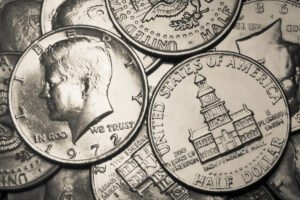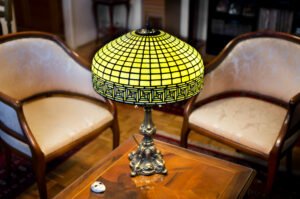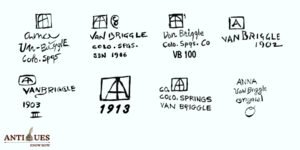The 1972 Kennedy Half Dollar is the second coin to follow the new copper-nickel-clad format in half dollars. Although minted in huge numbers, this coin can be worth a BIG fortune thanks to some exquisite characteristics.
However, if you don’t know what to look for, you may trade this late 20th-century coin for an unfavorable price. In this guide, I will explain all the special features, such as coin errors, obverse and reverse designs, and mint marks, to help you determine if your 1972 half-dollar is worth the money!
Brief History of the 1972 Kennedy Half Dollar
The Kennedy Half Dollar was first introduced in 1964, less than a year after President John F. Kennedy’s assassination. The coin was a tribute to the beloved president and quickly became popular among the American public.
Initially composed of 90% silver, the coin’s composition changed to a copper-nickel-clad format in 1971 due to rising silver prices. 1972 marked the second year of this new composition, transitioning away from silver in circulating half dollars.
By 1972, the Kennedy Half Dollar had been circulating for eight years. However, it was becoming less common in everyday transactions, partly due to people hoarding the earlier silver versions and the increasing use of vending machines that didn’t accept half dollars.
Despite this, the U.S. Mint continued to produce substantial quantities of the coin, making the 1972 issue an interesting study of American coinage during changing usage patterns.
| 1972 Kennedy Half Dollar | Key Features |
| Material Composition | 75% Copper & 25% Nickel |
| Minting Location | Philadelphia, Denver |
| Minting Year | 1972 |
| Weight | 11.34 grams |
| Diameter | 30.6mm |
| Thickness | 2.15mm |
| Designer | Gilroy Roberts (Obverse), Frank Gasparro (Reverse) |
| Face Value | $0.5 or 50 cents |
| Mint Marks | No Mint Mark-Philadelphia Mint, D-Denver Mint, S-San Francisco (proof) |
| Edge | Reeded |
| Total Mintage | 298,330,996 |
Spotting a 1972 Kennedy Half Dollar (Design & Composition)
The 1972 Kennedy Half Dollar was designed by two sculptors: Gilroy Roberts, who designed the obverse, and Frank Gasparro, who designed the coin’s reverse. These designs feature the following elements that make the coin identifiable.
1972 Kennedy Half Dollar Obverse:
- Left-facing profile of John F. Kennedy
- The word “LIBERTY” along the top edge
- The mint date “1972” at the bottom
- The U.S. motto “IN GOD WE TRUST” to the left of Kennedy’s neck
- The mint mark, if present, below Kennedy’s neck and above the date
- The designer’s initials “GR” (for Gilroy Roberts) under Kennedy’s neck
1972 Kennedy Half Dollar Reverse:

- Modified Presidential Seal featuring an eagle with outstretched wings
- Thirteen stars above the eagle’s head
- The words “UNITED STATES OF AMERICA” along the top edge
- The face value “HALF DOLLAR” at the bottom
- The words “E PLURIBUS UNUM” on a banner held in the eagle’s beak
- The designer’s initials “FG” (for Frank Gasparro) under the eagle’s left talon
Coin Composition, Size & Dimensions
The 1972 Kennedy Half Dollar was minted using a copper-nickel-clad composition, consisting of an inner copper core (79%) sandwiched between outer layers of a copper-nickel alloy (75% copper, 25% nickel).
This composition gave the coin a silver-like appearance without using the previous, expensive silver composition. Besides, the coin measures 30.61 mm in diameter and weighs 11.34 grams. It has a reeded edge containing 150 reeds.
Assessing the 1972 Kennedy Half Dollar Coin Value (4 Key Factors)
The value of a circulated 1972 Kennedy Half Dollar is the same as its face value of 50 cents. However, uncirculated half dollars or those with rare errors or features can fetch up to thousands.
Primarily, the value of 1972 half-dollar depends on the following factors:
1. Coin Grading and Condition
A coin’s condition is critical in assessing its true value. As for the 1972 Kennedy Half Dollars, the coins in the finest condition (graded MS65 or higher) are considered gem quality and command premium prices for hundreds to thousands, while circulated coins are worth less.
While you can analyze your coin’s condition visually, collectors prefer the coins graded by professional grading services, such as Professional Coin Grading Service (PCGS) and Numismatic Guaranty Company (NGC).
These facilities use the Sheldon Scale to assess the condition of coins, ranging from Poor (P-1) to Perfect Mint State (MS-70) to grade coins. You can refer to the following 1972 Kennedy Half Dollar value chart to understand how coin grades impact its worth:
| Coin Grades | 1972 50C No Mint Mark | 1972-D 50C |
| Poor (0) to Extremely Fine (XF45) | Face Value (up to 50 cents) | Face Value (up to 50 cents) |
| Almost Uncirculated (AU50) to Mint State (MS60) | $1 – $10 | $1 – $10 |
| Mint State (MS60 – MS66+) | $10 – $40 | $10 – $60 |
| Mint State (MS67 onwards) | $100 – $1,500+ | $80 – $1,600+ |
2. Mint Marks & Mintage
Often neglected, the coin mintage also greatly impacts its value; the lower the mintage, the rarer and more valuable the coin.
The total mintage for 1972 Kennedy Half Dollars across all mints was 298,330,996, including the 3.2 proof coins. The mint mark on the Denver and San Francisco-minted coins is present on the coin’s obverse below President Kennedy’s neck.
- 1972 No Mint Mark Half Dollar: The Philadelphia mint produced the highest number of 1972 half dollars, 153,180,000, all of which bear no mint mark. These coins are worth face value in circulated conditions, but uncirculated coins are worth $20 – $40, with MS67 examples fetching more.
- 1972-D Half Dollar: The Denver Mint struck around 141,890,000 Half Dollars in 1972. Due to their lower mintage, 1972-D half dollars are less common than 1972-P half dollars. In high-grade mint state, they can fetch up to $100 – $600 or more.
3. 1972-S Half Dollar Proof Coins
The United States Mint produced 3,260,996 proof Kennedy Half Dollars in 1972, all at the San Francisco Mint, which means they have the “S” mint mark. These coins were struck using polished dies on polished planchets, resulting in a mirror-like finish in the field and frosted raised designs.
Now, depending on the degree of contrast between the field and raised devices, the 1972 Kennedy Half Dollar proof coins are categorized into three varieties:
- Regular Proof: The regular 1972-S Kennedy Half Dollars proof coins have a normal, mirror-like surface across the fields and devices. Their value ranges from $5 to $20, with perfectly preserved PR69 examples potentially reaching $50 or more.
- Cameo Proof (CAM): Cameo proofs show a noticeable contrast between frosted devices and fields, making them more collectible and valuable. Cameo proofs of 1972 half dollars are worth $10 to $30 for average grades and $75 or more for PR69 examples.
- Deep Cameo (DCAM) Proof: Deep Cameo or Ultra Cameo proofs have the strongest contrast between the frosted devices and mirrored fields and are the most desirable of all proofs. Prices for Deep Cameo 1972-S half dollar proofs range from $20 to $50 for average specimens, with PR69 examples commanding $100 – $150 or more.
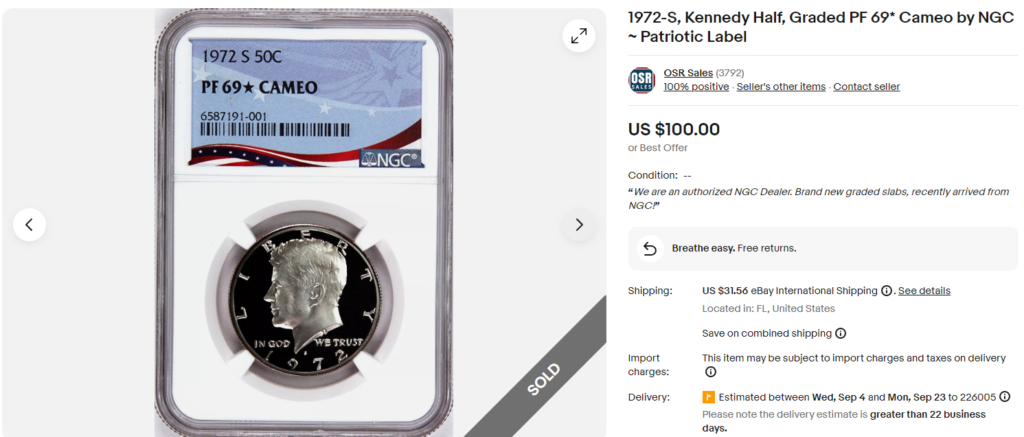
4. Rare Mint Errors on 1972 Kennedy Half Dollar
Minting errors are unique anomalies that occur when a coin is in the minting process. Such errors can significantly increase a 1972 half dollar coin’s value. Here are the most notable 1972 Kennedy Half Dollar errors to look for:
1972 50C Doubled Die Obverse
These error coins feature a visible doubling of the design elements on the 1972 50-cent coin’s obverse, especially the date, the word “LIBERTY,” and other elements. Lowly graded mint DDO half dollars are worth $100 – $200, while MS65+ examples can fetch more. I found an MS62-graded 1972 50C coin that sold for $156.
1972-D 50C No “FG”
The “No FG” error on a 1972 Kennedy Half Dollar is notable for the absence of the initials “FG” on the coin’s reverse side. The initials are usually found near the eagle’s tail in the lower right field, but some 1972 half dollars were struck without it.
This error likely happens when the die used to strike the coin either did not have the “FG” initials engraved or they were worn down or filled.
This rare error coin is quite valuable due to its rarity. I found an MS62-graded example that sold for almost $800 on eBay, an exceptional price for a 1972 half-dollar coin with this grade.
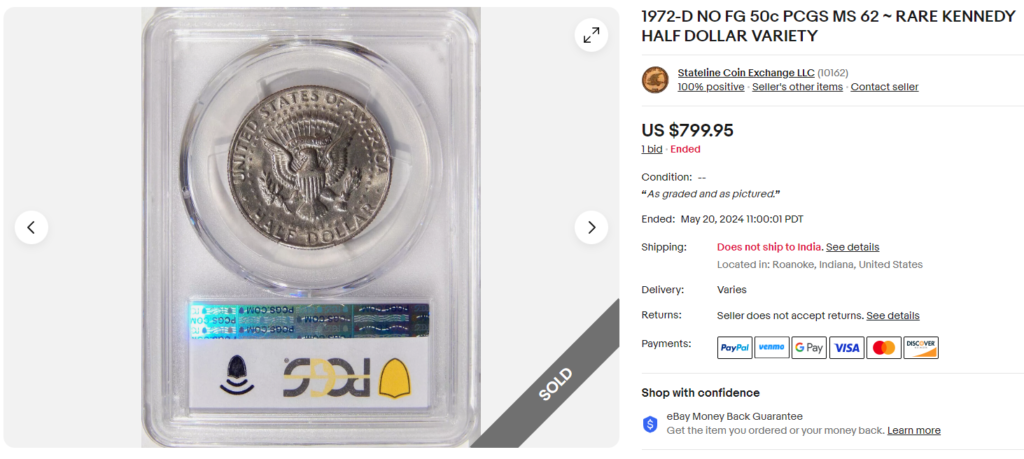
Double Struck, Rotated in Collar
This rare error is a result of two coin errors. Firstly, the 1972 Kennedy Half Dollar is struck twice, and secondly, the coin is rotated within the collar (the ring that holds the coin in place during striking). As a result, the second strike is misaligned to the first, creating a rotated double-struck effect.
Due to its rarity, this error can multiply the value of a regular 1972 half-dollar. A commonly-found MS63 1972-D half dollar with this error sold for $2,070 on Heritage Auctions, almost 200 times the value of a regular 1972-D graded MS63.
Overstruck on 1972-D Nickel
This rare coin is the result of a 1972 Kennedy Half Dollar being struck on a previously minted 1972-D Nickel. The nickel’s underlying design can sometimes be seen faintly through the overstruck Kennedy design.
Being extremely rare, this coin can be worth thousands of dollars in high-grade mint condition. Point in case, a rare MS66 graded example sold for an auction record price of $5,287 on Heritage Auctions!
Expert Tips to Identify a Fake 1972 Kennedy Half Dollar
Of course, special features can greatly boost the value of a 1972 half-dollar. However, you must be aware of counterfeits, which can trick you to spend big bucks with fake features.
Here are some expert tips to easily spot a fake 1972 Kennedy Half Dollar:
- Check the weight and dimensions against authentic 1972 half dollars. If these details deviate, it’s a fake coin.
- Examine the design details, especially the hairlines and lettering. A faded or soft design might indicate a fake.
- Verify the correct font and positioning of lettering, especially the mint mark and sculptor marks, if present.
- Look for signs of casting seams or file marks.
- Check the reeding on the edge for uniformity. Fake coins have no reeds or irregular reeding.
- Compare the coin’s color and luster to known genuine examples
- Use a magnet – genuine 1972 Kennedy Half Dollars should not be magnetic
In conclusion, the 1972 Kennedy Half Dollar can be a precious hidden gem worth more than you think. All you need to do is verify all the details, check for rare errors and mint marks using this guide, and assess its average value.
While the 1972 Kennedy Half Dollar itself is valuable, its predecessors, the 1971 Kennedy Half Dollar and the 1964 Kennedy Half Dollar, and its successor, the 1974 Kennedy Half Dollar, offer even greater potential for coin collectors!
Note: This article is intended for informational, educational, and entertainment purposes only. Some images are illustrative and may not represent actual brands, products, or related entities. All trademarks, product names, brand logos, packaging, and other intellectual property referenced remain the exclusive property of their respective owners. Any brand mentions or references are provided solely for descriptive and educational context and do not imply any formal or commercial association.

